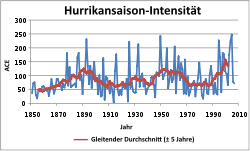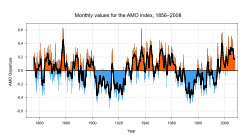- Atlantic Multidecadal Oscillation
-
 Der Verlauf der ACE von 1850 bis 2007 korreliert sehr gut mit dem Verlauf der AMO über diesen Zeitraum
Der Verlauf der ACE von 1850 bis 2007 korreliert sehr gut mit dem Verlauf der AMO über diesen ZeitraumDie Atlantische Multidekaden-Oszillation (Abkürzung AMO; Englisch: atlantic multidecadal oscillation) ist die Bezeichnung für eine zyklisch auftretende Zirkulationsschwankung der Ozeanströmungen im Nordatlantik. Sie bringt eine Veränderung der Meeresoberflächentemperaturen des gesamten nordatlantischen Beckens mit sich, wodurch Einfluss auf die Atmosphäre ausgeübt wird.
Die AMO hat eine Periodendauer von 50 bis 70 Jahren und besitzt ‚warme‘ und ‚kalte‘ Phasen. Von 1900 bis 1925 sowie von 1965 bis 1995 befand sie sich in einer kalten Phase, von 1925 bis 1965 und seit Mitte der 1990er Jahre in einer warmen Phase. Mit Hilfe von Baumring-Proxies konnten die Phasen der AMO bis zum Jahr 1567 rekonstruiert werden. Hinweise auf Phasenlage und -wechsel finden sich jedoch auch in Eisbohrkernen und Korallen. Da diese ausgeprägte Schwankung der Oberflächentemperatur des Atlantiks seit mindestens knapp 500 Jahren Bestand hat, ist anzunehmen, dass sie auch bei der künftigen Klimaentwicklung der Nordhemisphäre eine wesentliche Rolle spielt.[1][2][3][4]
Die Temperaturschwankungen werden durch veränderte Meeresströmungen sowie aufquellendes Tiefenwasser verursacht. Die Mehrzahl der Wissenschaftler ist der Ansicht, dass die AMO durch eine veränderte Geschwindigkeit der thermohalinen Zirkulation getrieben wird, die ihrerseits eine natürliche Schwankung im Klimasystem als Ursache hat. Eine beschleunigte Zirkulation führt zu einer positiven Phase der AMO, es wird mehr Wärme aus den Tropen in den Nordatlantik transportiert. Analog führt eine gebremste Zirkulation zu einer negativen Phase.[1][5][6]
Effekte der warmen Phase der AMO sind Dürren im Mittleren Westen und Südwesten der USA. In Florida und im Nordwesten der USA sowie in Europa fällt insgesamt mehr Niederschlag, wobei die Veränderungen in erster Linie im Sommer stattfinden. Es entwickeln sich mehr starke Hurrikans. Die Intensität des Indischen Monsuns und die Niederschlagsmengen in der Sahelzone sind erhöht; die mittlere Meereisbedeckung im arktischen Ozean ist geringer als in Zeiten mit negativem Index.[1][7][8][9]
Ein Phasenwechsel der AMO lässt den Zustrom zum Lake Okeechobee in Florida um 40% variieren, der Ausstrom des Mississippi variiert dagegen nur um 5-10%, die Niederschlagsmenge in Europa um 5-15%.[1][10]
Aufgrund der langen Zyklusdauer von ca. 60 Jahren und dem vergleichsweise kurzen Zeitraum, über den verlässliche Klimaaufzeichnungen existieren (ca. 150 Jahre), können Aussagen über klimabestimmende Einflüsse der AMO nur über wenige Zyklen überprüft werden und weisen von daher große Unsicherheiten auf. Klimaproxies erweitern den Datenraum zwar auf wenige hundert Jahre, besitzen jedoch eine geringere Genauigkeit. Ein genaues qualitatives und quantitatives Verständnis des Anteils dieser natürlichen Variabilität des Klimasystems erlaubt, natürliche von anthropogenen Klimaeinflüssen zu trennen sowie die Genauigkeit von Aussagen über die zu erwartende kurzfristige Entwicklung zu verbessern. Daher wurde versucht, angenommene klimatische Effekte der AMO in verschiedenen Klimamodellen (GFDL, HadCM3) unter Einbeziehung von direkten Klimaaufzeichnungen und Klimaproxies nachzuvollziehen; es zeigte sich, dass die Modelle nahezu alle tatsächlich beobachteten Phänomene bestätigten.[11][12]
Literatur
- N. G. Andronova, Schlesinger, M. E.: Causes of global temperature changes during the 19th and 20th centuries. In: Geophysical Research Letters. 27, 2000, S. 2137–2140
- R. A. Kerr: Atlantic climate pacemaker for millennia past, decades hence?. In: Science. 309, Nr. 5731, 2005, S. 41–43. doi:10.1126/science.309.5731.41
- R. T. Sutton, Hodson, L. R.: Atlantic forcing of North American and European summer climate. In: Science. 309, 2005, S. 115–118. doi:10.1126/science.1109496
Weblinks
- Atlantic Oceanographic and Meteorological Laboratory der NOAA: Projecting the Risk of Future Climate Regime Shifts html
Einzelnachweise
- ↑ a b c d Henk A. Dijkstra, te Raa, Lianke,: On the physics of the Atlantic Multidecadal Oscillation. In: Ocean Dynamics. 2005. doi:10.1007/s10236-005-0043-0
- ↑ S. T. Gray, et al.: A tree-ring based reconstruction of the Atlantic Multidecadal Oscillation since 1567 A.D.. In: Geophys. Res. Lett.. 31, 2004, S. L12205. doi:10.1029/2004GL019932
- ↑ R. A. Kerr: A North Atlantic climate pacemaker for the centuries. In: Science. 288, Nr. 5473, 2000, S. 1984–1986. doi:10.1126/science.288.5473.1984
- ↑ Steffen Hetzinger, et al.: Caribbean coral tracks Atlantic Multidecadal Oscillation and past hurricane activity. In: Geology. 36, Nr. 1, 2008, S. 11–14. doi:10.1130/G24321A.1
- ↑ Fred Pearce, Michael Le Page: "Climate change: the next ten years" New Scientist, 13 Aug. 2008, pp. 26-30.Online
- ↑ J. R. Knight: A signature of persistent natural thermohaline circulation cycles in observed climate. In: Geophys. Res. Lett.. 32, 2005, S. L20708. doi:10.1029/2005GL024233
- ↑ McCabe, G. J., Palecki, M. A.; Betancourt, J. L.: Pacific and Atlantic Ocean influences on multidecadal drought frequency in the United States. In: PNAS. 101, 2004, S. 4136–4141. doi:10.1073/pnas.0306738101
- ↑ Goldenberg, S. B.; et al. (2001): The recent increase in Atlantic hurricane activity: Causes and implications. In: Science 293, S. 474–479. doi:10.1126/science.1060040
- ↑ Rong Zhang: Impact of Atlantic multidecadal oscillations on India/Sahel rainfall and Atlantic hurricanes. In: Geophys. Res. Lett.. 9 2006, S. L17712. doi:10.1029/2006GL026267 Online (PDF)
- ↑ D. B. Enfield, Mestas-Nunez, A. M.; Trimble, P. J.: The Atlantic Multidecadal Oscillation and its relationship to rainfall and river flows in the continental U.S.. In: Geophys. Res. Lett.. 28, 2001, S. 2077–2080
- ↑ J. R. Knight, C. K. Folland, and A. A. Scaife: Climate impacts of the Atlantic Multidecadal Oscillation. In: Geophys. Res. Lett.. 2006, S. L17706. doi:10.1029/2006GL026242
- ↑ T. L. Delworth, Mann, M. E.: Observed and simulated multidecadal variability in the Northern Hemisphere. In: Climate Dynamics. 16, 2000, S. 661–676. doi:10.1007/s003820000075
Wikimedia Foundation.

